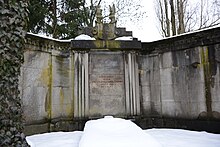Wilhelm Liebermann von Wahlendorf

Wilhelm Ritter Liebermann von Wahlendorf (born October 6, 1863 in Berlin , † 1939 in London ) was a German-Jewish chemist and entrepreneur.
Life
Growing up in Berlin, Liebermann attended the Royal Wilhelms-Gymnasium in addition to his education with various tutors . After graduating from high school , he studied chemistry at the Julius Maximilians University of Würzburg and the Hessian Ludwig University of Gießen . In 1884 he became active in the Corps Starkenburgia . Corps student education and its concept of honor had a lasting impact on his life.
In 1885 he worked at a chemical laboratory in Berlin. In 1886/87 he served as a one-year volunteer with the Schleswig-Holstein Uhlan Regiment No. 15 in Strasbourg . In view of the widespread anti-Semitism in the Prussian Army, he soon dropped his initial desire to switch to an officer career . After his departure he challenged a captain of his regiment to a duel (the first of a total of four pistol duels that he fought in the course of his life). The affair caused quite a stir and was also discussed in the Reichstag (German Empire) . Liebermann fled to Belgium , but surrendered to the German authorities. He became imprisonment convicted and pardoned after nine months. He continued his chemical investigations continued and received his doctorate in 1890 in Rostock to Dr. phil. Food chemistry was also the focus of his other research. He himself was involved in several industrial companies, including the chemical factory Balzer & Co. in Berlin-Grünau and the chemical factory Berlin-Köpenick .
In 1902 Willy Liebermann married Elisabeth Lenning (1880–1946), from whom he divorced in 1908. The marriage resulted in the daughters Madeleine (* 1903) and Ellen (* 1904). Since 1910 he was his second marriage to Maidi geb. Feist-Belmont (1884–1971) married. The marriage comes from the son Edgar (1910-1996). Maidi Liebermann was Ludwig Thoma's lover from 1918 to 1921 . Despite the love affair he knew, Willy Liebermann refused to divorce, which only took place in 1926, long after Thomas' death. In 1928 Liebermann married for the third time.
Regardless of his integration into the upper-class aristocratic society of the empire , Liebermann never denied that he belonged to Judaism . He strictly opposed the Christian baptisms widespread among the Jewish bourgeoisie for the purpose of professional careers . In view of the threat posed by National Socialism , he supported the German National People's Party . Ultimately without success, he made his influence available to the Central Association of German Citizens of the Jewish Faith . After the seizure of power by the Nazis he retired into exile to England , where he in 1939 died.
Liebermann's memoirs, which he wrote in Merano in 1936 and which he himself named Mein Kampf , were recognized in 1988 as memories of a German Jew. Published 1863–1936 by Piper Verlag . In his epilogue, Ernst Piper describes the book as "a source of contemporary history of high standing, as we have before us a representative of two lost worlds, the world of the German upper middle class on the one hand and the world of German Jewry on the other". At the same time, they are eloquent testimony to the bourgeois anti-Semitism to which Liebermann was repeatedly exposed.
family

born in 1876, humiliated - defamed ,
dead January 8, 1943 ”.
Budapester Straße 45, Berlin
(widow of brother Paul (1861–1930), i.e. sister-in-law of Wilhelm Liebermann von Wahlendorf)
Willy Liebermann's grandfather Josef Liebermann founded the first German factory for mechanical calico printing , which later rose to become the largest calico factory in Germany. In doing so, he laid the foundation for the family's material wealth.
Willy Liebermann's father Adolf Liebermann (1829–1893) made a name for himself as an art collector . Among other things, he owned Adolf von Menzel's “iron rolling mill” , which is now in the National Gallery in Berlin . In 1873 he was raised to the Austrian nobility by the then Austrian Emperor Franz Joseph I as "Knight Liebermann von Wahlendorf" . In view of his services to art, he was also allowed to use the title of nobility in Prussia .
Willy Liebermann von Wahlendorf was the cousin of the painter Max Liebermann , the chemist Carl Liebermann , the historian Felix Liebermann and the AEG founder Emil Rathenau (father of the later Reich Foreign Minister Walter Rathenau ).
Works
- Memories of a German Jew. 1863-1936 . Munich 1988
Individual evidence
- ↑ Kösener corps lists 1960, 37 , 456. - The short-term membership in the Corps Moenania Würzburg is not documented in the Kösener corps lists from 1910 and in the Kösener corps lists from 1930 and 1960, but it is autobiographical in his memoirs (p. 40 ff.) mentioned in detail.
- ↑ See also the entry of Wilhelm von Liebermann's matriculation in the Rostock matriculation portal
- ↑ Dissertation: Contributions to the question about the determination of small amounts of cow butter fat in margarine .
Web link
- Literature by and about Wilhelm Liebermann von Wahlendorf in the catalog of the German National Library
| personal data | |
|---|---|
| SURNAME | Liebermann von Wahlendorf, Wilhelm |
| ALTERNATIVE NAMES | Liebermann von Wahlendorf, Wilhelm Edgar Salomon Ritter (full name) |
| BRIEF DESCRIPTION | German-Jewish chemist and entrepreneur |
| DATE OF BIRTH | October 6, 1863 |
| PLACE OF BIRTH | Berlin |
| DATE OF DEATH | 1939 |
| Place of death | London |